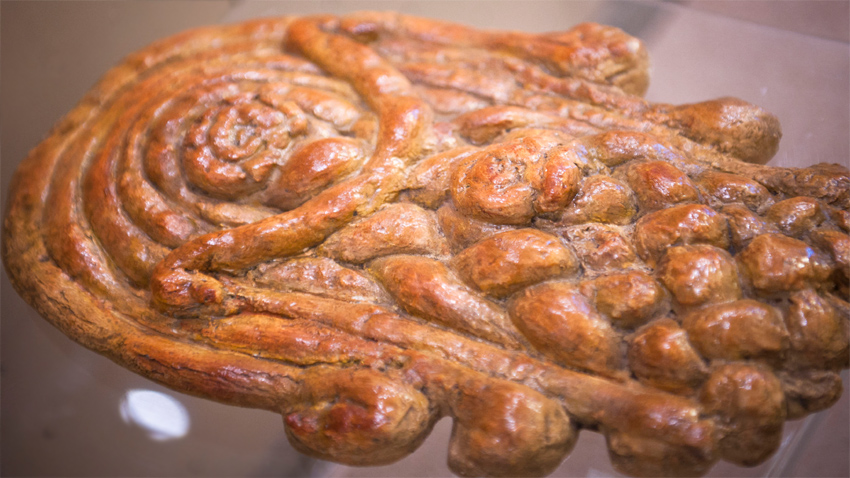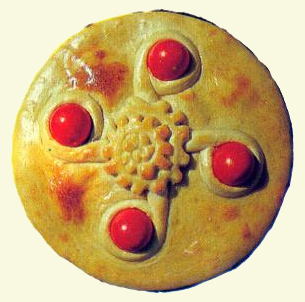Easter ring-bun, Easter doll, knotwork, egg-pudding… These are all different names given to the ritual loaves baked for the biggest of all Christian feast days, Easter. How are they made and decorated and what is their role in folklore tradition?
Kozunak or Easter cake, this delicious latter-day symbol of Easter entered Bulgarian tradition relatively late. There is no word kozunak in The Dictionary of the Bulgarian Language, Naiden Gerov’s most important work, published on the threshold of the 20th century. In the course of ten years, Gerov put down on paper over 70,000 words and 10,000 set phrases, “out of the mouth of the people” which he later collected in five volumes. Dimitar Marinov – a dedicated researcher into Bulgarian tradition whose work covers the period right up to the beginning of the 20th century – makes no mention of the word either, though he does give considerable space to the different kinds of Easter bread. While making the rounds of villages across the country, he described 150 different kinds of decorated loaves. He photographed and sketched them and the loaves themselves he took away with him to the Ethnographic Museum which he was director of. Dimitar Marinov writes that ritual loaves were part of all Bulgarian tradition. Alongside water and wine, they were part of the offerings made – in fact the ritual revolved around them. The symbols used to decorate them had their own stories to tell.

The bulk of the preparations for the feast day fell on Maundy Thursday. Early in the morning the women of the house would dye the eggs. “The mistress of the house would give lasses and brides a red egg each to carry next to their bosom until Easter when they would hear the words “Christ is Risen!” then they would break and eat them,” writes Dimitar Marinov. This is followed by another ritual performed while the dough for the ritual bread was being kneaded – renewing the leaven. According to popular belief, a village home must never be left without leaven because without it there could be no bumper harvest. That is why every good housewife took great care to have leaven at home for making ordinary, but also ritual loaves of bread. On Maundy Thursday the leaven was “renewed” and would then be used throughout the year. Once, women would sing special songs during this ritual. The oldest women of the house would knead some dough with medicinal herbs in it and leave it covered up with a new piece of cloth.
 Once the leaven started to rise and to “turn sour” i.e. once the process of fermentation had begun, they would knead the ritual loaves. Before starting to make the bread, the women of the house would wash up and don their best clothes. The flour was made of the best wheat, put aside for the purpose in summer. It would be carefully sifted, sometimes through three sieves, described in folk songs as “silken”. When it was ready it would be thurified. The water for the dough is said to be “silent” or “colour” water that has not been drunk of – water that has been brought from the well in complete silence in a clean pail with flowers and herbs inside.
Once the leaven started to rise and to “turn sour” i.e. once the process of fermentation had begun, they would knead the ritual loaves. Before starting to make the bread, the women of the house would wash up and don their best clothes. The flour was made of the best wheat, put aside for the purpose in summer. It would be carefully sifted, sometimes through three sieves, described in folk songs as “silken”. When it was ready it would be thurified. The water for the dough is said to be “silent” or “colour” water that has not been drunk of – water that has been brought from the well in complete silence in a clean pail with flowers and herbs inside.
The names given to the Easter loaves of bread depend on their shape and purpose. Some of the names are used on other feast days as well – kolak, kravay, bogovitsa, parmak. What makes Easter bread different are the eggs placed on it before the last time the dough rises. Usually, the eggs would be entwined with pieces of dough for decoration. The Velikdenska kukla (Easter puppet) is a long bar of dough, twisted back on itself several times, with the ends curving out. A red egg was placed in its upper end and it was given to a young bride. The godfather (best man) got an Easter kolak – a round loaf with four or more eggs on it. One variety of Easter bread is called kumichni kolachi (derived from the word kumitsa). It was given to the kumitsa – a woman who took part in the spring maiden ritual kumichene, which involved pre-marital fortune telling and incantation.
Even though the kozunak has been part of Bulgarian tradition for no more than 100 years, Bulgarian cuisine features what is known as vladishka pita (episcopal bread) which is very similar to the kozunak. It is made out of eggs, sugar, yoghurt, butter or vegetable oil, with dried or fresh fruit, cinnamon and of course – flour and leaven. The episcopal bread has a Lenten variety which is just as delicious. And one more important thing – you should never cut the kozunak with a knife, but break it with your hands.
English version: Milena Daynova
Photos: BGNES and libraryLazarus Saturday is widely known in Bulgaria as Lazarovden , celebrated by Orthodox Bulgarians on the day before Palm Sunday. The main rite is the lazaruvane - a traditional custom centred on themes of love and marriage. Girls over the age of 16,..
The historic town of Tryavna will celebrate St Lazarus' Day, traditionally held on the Saturday before Palm Sunday. The Bulgarian custom, known as lazaruvane , is closely linked to the themes of love and marriage and will be re-enacted this..
The feast of the Annunciation (Blagoveshtenie in Bulgaria) is a holy day , a symbol of God’s infinite mercy to people and especially to women, blessed to bear new life, but also an embodiment of the eternal human longing for something better in the..

+359 2 9336 661
